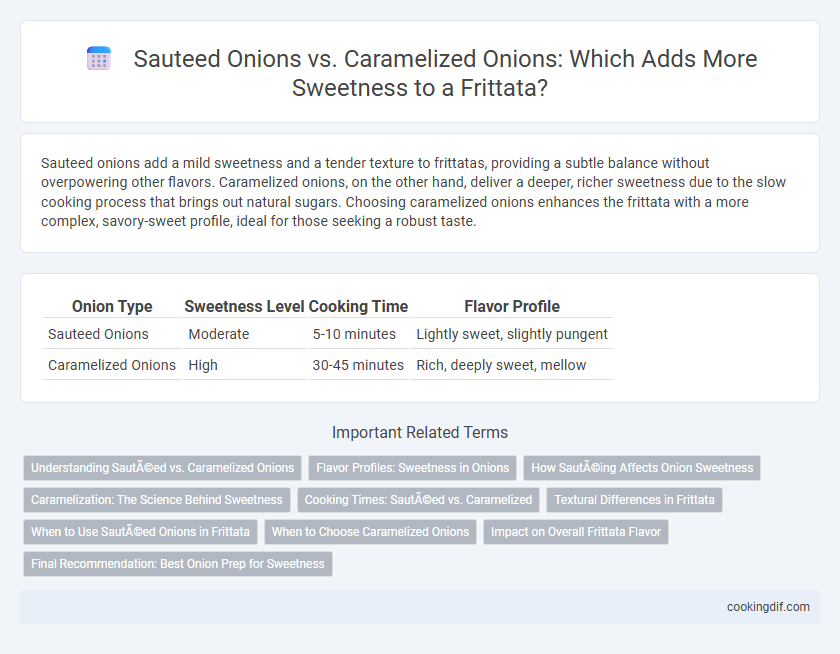Sauteed onions add a mild sweetness and a tender texture to frittatas, providing a subtle balance without overpowering other flavors. Caramelized onions, on the other hand, deliver a deeper, richer sweetness due to the slow cooking process that brings out natural sugars. Choosing caramelized onions enhances the frittata with a more complex, savory-sweet profile, ideal for those seeking a robust taste.
Table of Comparison
| Onion Type | Sweetness Level | Cooking Time | Flavor Profile |
|---|---|---|---|
| Sauteed Onions | Moderate | 5-10 minutes | Lightly sweet, slightly pungent |
| Caramelized Onions | High | 30-45 minutes | Rich, deeply sweet, mellow |
Understanding Sautéed vs. Caramelized Onions
Sauteed onions retain a mild sweetness and a slightly crisp texture as they are cooked quickly over medium-high heat. Caramelized onions develop a deep, rich sweetness and a soft, jam-like consistency due to slow cooking over low heat, allowing natural sugars to brown thoroughly. Understanding the difference between sauteed and caramelized onions helps enhance frittata flavor by choosing the right onion preparation to balance sweetness and texture.
Flavor Profiles: Sweetness in Onions
Sauteed onions provide a mild sweetness with a slight bite, enhancing the frittata's overall flavor without overpowering other ingredients. Caramelized onions develop a deep, rich sweetness through slow cooking, adding complex layers and a velvety texture that intensifies the dish's savory profile. The choice between sauteed and caramelized onions significantly impacts the frittata's sweetness, balancing freshness and depth.
How Sautéing Affects Onion Sweetness
Sauteing onions softens their texture and releases some natural sugars, offering a mild sweetness that enhances dishes without overpowering flavors. The process involves cooking onions over medium-high heat for a short time, which lightly browns them but retains a firmer bite compared to caramelized onions. This quick method intensifies sweetness subtly, making sauteed onions ideal for balanced recipes where gentle onion flavor is preferred in frittatas.
Caramelization: The Science Behind Sweetness
Caramelization transforms onions by slowly heating their natural sugars, resulting in a rich, sweet flavor and deep amber color that sauteing alone cannot achieve. The Maillard reaction during caramelization breaks down complex sugars into simpler, sweeter compounds, enhancing the overall sweetness and sensory depth of the dish. Unlike quick sauteing, caramelized onions require low heat and patience to develop their signature sweetness and texture, making them ideal for recipes like frittatas seeking complex flavor profiles.
Cooking Times: Sautéed vs. Caramelized
Sauteed onions cook quickly, typically softening within 5 to 10 minutes over medium-high heat, offering a mild sweetness with a slight bite ideal for frittatas. Caramelized onions require low heat and extended cooking times of 30 to 45 minutes, transforming natural sugars into a deep, rich sweetness that adds complexity and depth to the dish. Choosing between sauteed or caramelized onions depends on desired sweetness intensity and texture in the frittata.
Textural Differences in Frittata
Sauteed onions in a frittata provide a crisp, slightly tender texture that enhances the overall bite, while caramelized onions offer a rich, soft, and velvety consistency that blends seamlessly into the egg base. The sauteing process preserves the onion's structural integrity, creating distinct layers in each slice, whereas caramelization breaks down the onions, contributing a smooth, jam-like texture. Choosing between these methods impacts both the mouthfeel and layering of flavors, with sauteed onions adding crunch and caramelized onions delivering a buttery, melt-in-the-mouth experience.
When to Use Sautéed Onions in Frittata
Sauteed onions offer a mild sweetness and tender texture ideal for a quick-cooking frittata, preserving their subtle flavor without overpowering other ingredients. Use sauteed onions when you want a fresher, less intense onion presence that blends smoothly with eggs and vegetables. Their brief cooking time maintains a light, savory profile perfect for delicate flavor combinations.
When to Choose Caramelized Onions
Caramelized onions offer a deep, rich sweetness ideal for slow-cooked dishes like frittatas with savory, complex flavors. Choose caramelized onions when you want to add a mellow, umami-rich layer that enhances ingredients like mushrooms, cheese, or herbs. Their natural sugars develop fully during the slow browning process, providing intense sweetness that sauteed onions lack.
Impact on Overall Frittata Flavor
Sauteed onions provide a mild sweetness and a slightly crisp texture that enhances a frittata's freshness without overpowering other ingredients. Caramelized onions offer a deeper, richer sweetness with a complex, umami flavor that adds depth and a subtle molasses note, profoundly influencing the overall taste profile. Choosing between the two affects the frittata's balance, as caramelized onions create a more robust and savory dish, while sauteed onions maintain a lighter, more delicate flavor.
Final Recommendation: Best Onion Prep for Sweetness
Caramelized onions provide a deeper, richer sweetness due to the slow cooking process that breaks down natural sugars, resulting in a complex flavor ideal for enhancing frittatas. Sauteed onions offer a lighter, more pungent sweetness but lack the intense, mellow notes that caramelization develops. For maximum sweetness and a balanced savory profile in frittatas, caramelized onions are the best choice for onion preparation.
Sautéed onions vs Caramelized onions for sweetness Infographic

 cookingdif.com
cookingdif.com